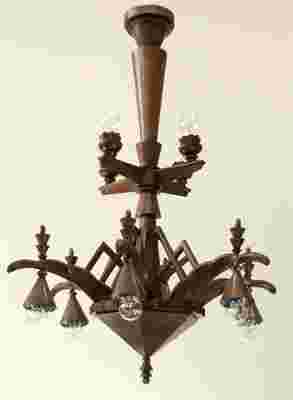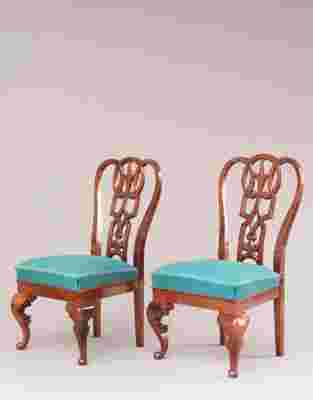July 28,2022
Rare Weimar-Era Furniture on View at a New York Exhibition
by David Stewart
Bauhaus rigor may be the first thing that comes to mind when 20th-century German design is mentioned, but for Markus Winter of Lampedo gallery, the fanciful furnishings made shortly before the country’s mania for tubular steel set in are a lot more fun.
“All of this would broadly have been considered degenerate” by the Nazis, Winter says of the 31 fantastically carved or lusciously lacquered furnishings and accessories he has assembled for “Berlin Deko: German Furniture, 1910–1930,” a captivating exhibition on view through November 21 (appointment suggested) at Brian Kish’s Manhattan gallery. One might imagine, too, that the forward-focused professors at Staatliches Bauhaus were frankly appalled by the romanticism that flourished on the other side of the aesthetic aisle.

Fritz August Breuhaus is the likely designer of this walnut chandelier, which was made around 1919.
At Lampedo, creations that seem to blend folk art, fairy tales, and the Brothers Grimm are set within a windowless room spangled with jagged black-and-white patterns that recall the discombobulating sets of The Cabinet of Dr. Caligari, the 1920 German silent thriller. The decor is apt, considering that even the most luxurious furnishings on view seem infused with Expressionism.

Circa-1923 walnut side chairs by Hungarian modernist Lajos Kozma, whose works complement those of his German contemporaries.
Call it Mod Gemütlich. Curling vines bearing shell-like pods crawl up a 1914 oak tall-case clock ($48,000) by architect Eduard Pfeiffer, who topped the timepiece with an imperious hoop-skirted lady clutching a tulip. From the ceiling hangs a spidery circa-1919 walnut chandelier ($30,000) that Winter attributes to architect Fritz August Breuhaus, its polished foliate arms dripping with upside-down cones. And against one wall hunkers a burly chest of drawers ($19,000) that is likely the work of Karl Pullich, an artist, decorator, and academic who outfitted the wedge-shaped storage unit with octagonal knobs and stylized blooms resembling a court jester’s cap.
As inventive in form as they are traditional in craftsmanship and motifs and often calling on Baroque and Rococo precedent for silhouettes that could be given a contemporary twist, Lampedo’s Weimar-era treasures are “playful and very narrative,” Winter explains. Relatively rare too. “It was difficult to come up with enough material for a show because there isn’t a lot—I wasn’t even taught about it in art school,” the dealer says. Small wonder, he notes, since at the time French Art Deco was all the rage, its German equivalent was barely on the international map.
For more information about “Berlin Deko,” go to lampedoom.






